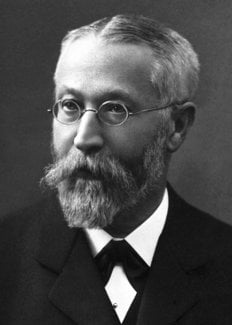Ferdinand Braun
Biographical

Karl Ferdinand Braun was born on June 6, 1850 at Fulda, where he was educated at the local “Gymnasium” (grammar school). He studied at the Universities of Marburg and Berlin and graduated in 1872 with a paper on the oscillations of elastic strings. He worked as assistant to Professor Quincke at Würzburg University and in 1874 accepted a teaching appointment to the St. Thomas Gymnasium in Leipzig. Two years later he was appointed Extraordinary Professor of Theoretical Physics at the University of Marburg, and in 1880 he was invited to fill a similar post at Strasbourg University. Braun was made Professor of Physics at the Technische Hochschule in Karlsruhe in 1883 and was finally invited by the University of Tübingen in 1885; one of his tasks there was to build a new Physics Institute. Ten years later, in 1895, he returned to Strasbourg as Principal of the Physics Institute, where he remained, in spite of an invitation from Leipzig University to succeed G. Wiedemann.
Braun’s first investigations were concerned with oscillations of strings and elastic rods, especially with regard to the influence of the amplitude and environment of rods on their oscillations. Other studies were based on thermodynamic principles, such as those on the influence of pressure on the solubility of solids.
His most important works, however, were in the field of electricity. He published papers on deviations from Ohm’s law and on the calculations of the electromotive force of reversible galvanic elements from thermal sources. His practical experiments led him to invent what is now called Braun’s electrometer, and also a cathode-ray oscillograph, constructed in 1897.
In 1898 he started to occupy himself with wireless telegraphy, by attempting to transmit Morse signals through water by means of high-frequency currents. Subsequently he introduced the closed circuit of oscillation into wireless telegraphy, and was one of the first to send electric waves in definite directions. In 1902 he succeeded in receiving definitely directed messages by means of inclined beam antennae.
Braun’s papers on wireless telegraphy were published in 1901 in the form of a brochure under the title Drahtlose Telegraphie durch Wasser und Luff (Wireless telegraphy through water and air).
After the outbreak of the First World War, Braun was summoned to New York to attend as a witness in a lawsuit regarding a patent claim. Owing to his absence from his laboratory and due to illness he was unable to carry out further scientific work. Braun thus spent the last years of his life peacefully in the United States, where he died on April 20, 1918.
This autobiography/biography was written at the time of the award and first published in the book series Les Prix Nobel. It was later edited and republished in Nobel Lectures. To cite this document, always state the source as shown above.
The Nobel Foundation's copyright has expired.Nobel Prizes and laureates
Six prizes were awarded for achievements that have conferred the greatest benefit to humankind. The 14 laureates' work and discoveries range from quantum tunnelling to promoting democratic rights.
See them all presented here.
